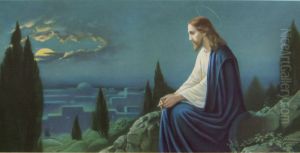Josef Untersberger Paintings
Josef Untersberger, also known as Giuseppe Gustavino, was an Austrian-Italian painter born on March 1, 1864, in Gmunden, Austria. He was known for his historical and religious paintings, as well as his decorative frescoes. His style was marked by a blend of academic painting with elements of the Art Nouveau movement, which was popular during his time.
Untersberger received his artistic training at the Academy of Fine Arts in Munich, Germany, where he studied under the guidance of notable artists such as Gabriel von Hackl and Ludwig von Löfftz. After completing his studies, he embarked on a successful career as an artist, receiving commissions from various patrons, including religious institutions and members of the aristocracy.
Throughout his career, Untersberger worked on numerous frescoes and altarpieces, many of which are located in churches across Austria and Bavaria. He was particularly admired for his ability to depict religious subjects with a sense of grandeur and emotional depth, a skill that earned him a reputation as a master of ecclesiastical art.
Despite his success, Josef Untersberger remains a relatively obscure figure in the annals of art history, partly due to the fact that he did not fit neatly into any one particular art movement or school. His work, however, continues to be appreciated by those who encounter it, particularly in the context of the religious settings for which it was created.
Untersberger's personal life is not as well documented as his artistic career, but it is known that he spent much of his life working in the region where he was born. He passed away on June 29, 1933, in Gmunden, leaving behind a legacy of work that continues to inspire admiration for its craftsmanship and devotion to religious themes.
